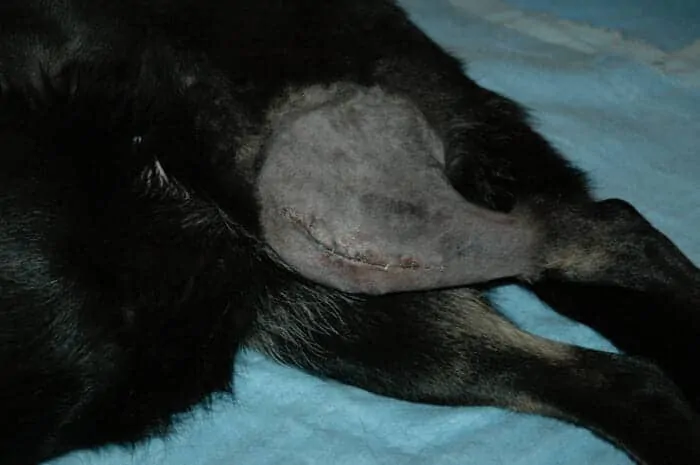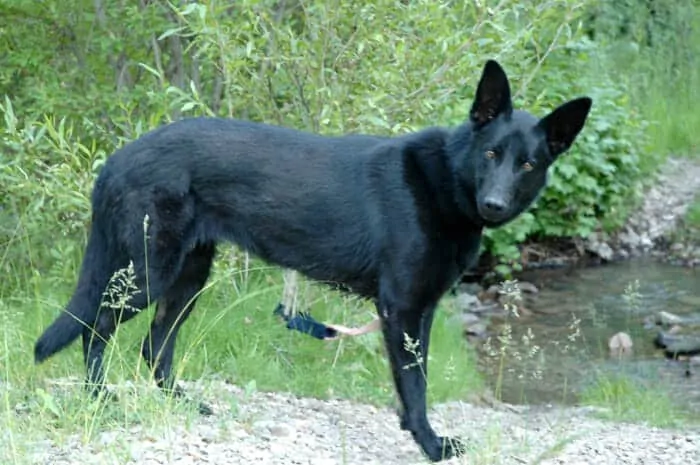My black German Shepherd was about nine years old, healthy, and active when she came into the house one night limping on her back leg. I thought she might have pulled a muscle or something, as she liked to dash about the backyard, particularly if there was a cat around!
I waited to see how she was doing the next morning, but she wasn’t any better, so off we went to the vet.
I was surprised to learn that she had suffered from a serious injury—a tear in her cranial cruciate ligament (CCL), which is similar to the anterior cruciate ligament (ACL) in humans. The two are so similar that the injury is typically called a “torn ACL” in dogs.
“How on earth did she do that?” was my first question. Then, “How can we fix it?”
My black German Shepherd, Morrigan, enjoying a camping trip.
Contents
What is a Torn ACL in Dogs?
The CCL in dogs is a short band of tough, flexible tissue that connects the back of the femur or thighbone to the front of the tibia or shinbone. It helps stabilize the knee joint and keeps the tibia in place as the dog moves. Since the dog’s back knee is always slightly bent when standing, the CCL is always bearing weight, which makes it vulnerable to injury.
According to a 2003 study, a torn or ruptured CCL is the most common orthopedic problem seen in veterinary practices around the world.
When the CCL becomes strained or torn, it can cause lameness and other symptoms including swelling, inability to walk on the leg, and pain. In active dogs like mine, a sudden movement such as a jump, twist, turn, or bad landing usually causes the tear.
According to Colorado State University, some dogs are more vulnerable to these injuries than others, including:
- Older animals—the ligament can slowly degenerate over time; research shows that most injuries occur around the age of 7-8 years
- Overweight and obese animals—the extra weight puts more pressure on the knee
- Dogs in poor physical condition
- Dogs with conformation issues, such as deformities in the knee
- Breed (some breeds are prone to these injuries, including the Rottweiler, Newfoundland, Staffordshire Terrier, Mastiff, Akita, Saint Bernard, Chesapeake Bay Retriever, and Labrador Retriever)
The severity of the injury can vary, from a partial tearing of the ligament to a complete tear. An animal that suffers a partial tear may begin to limp just a little at first, but without treatment, the tear will typically worsen until the lameness becomes severe.
Several breeds of dog, including the Akita, are particularly vulnerable to ACL injuries.
Symptoms of a Torn ACL in Dogs
The first sign of a problem is always limping or lameness. The knee may feel warm to the touch, and the dog may show signs of pain or tenderness. Other symptoms include:
- Putting one leg out to the side when sitting down
- Difficulty getting up after lying down
- Trouble jumping, such as into a car
- Reduced activity
- Shifting the weight away from the injured leg
- A popping noise when moving the leg
- Inability to move the knee as far as before
- Swelling inside the shinbone
- Hopping on three legs
Diagnosis of a Canine Torn CCL
If your dog shows signs of limping for more than a day, it’s always best to check with your veterinarian. A simple muscle injury can indeed cause limping, and it usually resolves on its own in a few days, so you do have the choice of resting your dog to see if the lameness disappears.
Keep in mind, however, that early diagnosis and treatment of a CCL injury is preferable to waiting for the injury to get worse.
My veterinarian suspected the torn CCL and took X-rays to confirm her thoughts. It’s not always easy to identify the tear, particularly if it’s only partial, so your vet may need to perform additional imaging tests or even an MRI. He or she will also likely perform some manipulation of the knee to determine how it’s acting.
Once the condition is confirmed, it’s time to decide how to treat it.
Morrigan was a very active dog, and may have torn her ACL while running or quickly shifting directions.
Questions to Ask About Treatment for ACL Injuries in Dogs
When my vet first explained the treatment options for my dog, I felt very anxious about it. What if I made the wrong choice?
If your dog is diagnosed with this injury, below are some of the questions you’ll probably want answered.
Can my dog live with an ACL injury?
It is not a good idea to avoid treatment for this injury, as it is painful and will only get worse. The body will try to stabilize the injured area with scar tissue, but it won’t be strong enough to keep the knee stable. Scar tissue will also limit range of motion.
As the dog avoids using the knee, the muscles will weaken and atrophy, while the dog will put more weight on the other knee—increasing the risk of the same injury occurring on the other side. Up to 50 percent of animals that suffer a torn CCL will eventually suffer another in the opposite knee.
Without treatment, the dog may also suffer a tearing of the meniscus, which is the knee cartilage. This injury is particularly painful, and will further limit your dog’s ability to be active, which eventually will lead to weight gain and other problems.
Morrigan had no problem balancing on her hind legs prior to her injury—here she’s playing with my cat, Sam! After the surgery I was careful to make sure I didn’t encourage her into this posture.
Can my dog recover from an ACL tear without surgery?
Most of the time, a CCL injury requires surgery, but in some cases, such as when the tear is mild, the dog is too old for surgery, or you simply can’t afford surgery, a knee brace may serve as a less optimal alternative.
Knee braces help support the knee joint while the dog is healing, and may help your dog, though it’s important to understand that the injury is not likely to heal completely this way. Talk to your veterinarian about your options. Smaller dogs under 30 pounds are more likely to manage with a knee brace, but if the ligament is completely torn, surgery will still be necessary.
What are the surgical treatment options?
Surgery is usually the best choice for your dog, as it helps stabilize the knee and reduces the chances of cartilage damage and weakening of the opposite knee. It’s important to know your options.
- Extracapsular Repair: This is a more traditional surgery, and involves replacing the torn ligament with a false ligament on the outside of the joint. This procedure typically costs about $1,200 – $2,500. (Watch this repair being done in this video.)
- Tibial Plateau Leveling Osteotomy (TPLO): This is a more complex bone surgery, and involves cutting the tibia and rotating it into a more flat position. Cost is between $2,400 – $4,500. (If you have a strong stomach, you can watch the surgery performed here.)
- Tibial Tuberosity Advancement (TTA): This is also a bone surgery, and involves cutting the front part of the tibia and placing a spacer within the cut, then securing the bone in place with a metal plate. This costs between $3,500 – $4,500.
Morrigan’s knee immediately after surgery. It looks scary, but it healed really quickly, as you can see in the picture below.
Which surgery is best for my dog?
The best surgery for your dog depends on the severity of the injury, the size of your dog, the dog’s age, and the dog’s health condition. Extracapsular repair is the most conservative option and the most commonly performed ACL surgery and is typically recommended for dogs less than 50 pounds, though it can work well for larger dogs, too.
The TPLO surgery has proven to be a very effective long-term solution for dogs and tends to return stability to the joint immediately. It’s often recommended for younger, very active dogs that need to return to that level of activity, or for larger dogs.
TTA surgery also allows for a more rapid return to full activity, though dogs must restrict exercise for 8-16 weeks. In general, dogs undergoing TTA can use the injured leg about 2 weeks faster than dogs receiving a TPLO. Long-term, however, TPLO tends to perform better, though the difference is small. Dogs undergoing TTA procedures are also more at risk for meniscal tears.
My vet recommended TPLO for my dog, but I chose extracapsular repair because of the cost, her older age, and because I liked the idea of conservative surgery. I was initially nervous about this choice, but I’m happy to say that the surgery worked well and she moved just fine on that knee for the rest of her life.
You and your vet can work out the best choice for your animal. It is important to be sure the dog gets the proper rest after surgery and moves into activity gradually.
What if I can’t afford surgery?
These surgeries are expensive and can create financial difficulties for some families. Some veterinary clinics will offer payment plans or will give you the option of applying for Care Credit—a personal line of credit for healthcare treatments.
ACL surgery can be frightening, but Morrigan recovered completely and went on to enjoy a long, healthy life. Your dog can, too!
Keep Your Chin Up—Your Dog Will Feel Better!
Going through an ACL injury with your dog can be frightening. I felt so badly for my dog, but she recovered remarkably quickly and went on to enjoy an active, healthy life. Your dog, too, will get better with treatment, so hang in there. Soon you’ll both be out enjoying life once again!

Jen Jones is a professional dog trainer and behavior specialist with more than 25 years of experience. As the founder of ‘Your Dog Advisor’ and the ‘Canine Connection’ rehabilitation center, she applies a holistic, empathetic approach, aiming to address root causes rather than merely treating symptoms.
Well known for her intuitive and compassionate approach, Jen adopts scientifically-proven, reward-based methods, encouraging positive reinforcement over punishment. Jen specializes in obedience training, behavior modification, and puppy socialization. Her innovative methods, particularly in addressing anxiety and aggression issues, have been widely recognized. Jen has worked with many of the world’s leading dog behaviorists and in her free time volunteers with local animal shelters and rescue groups.







